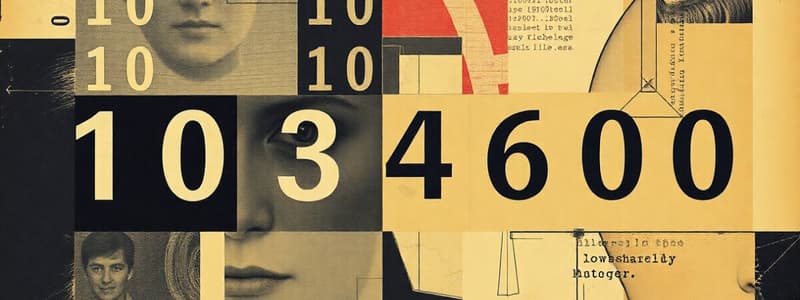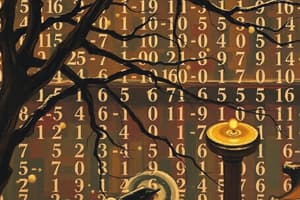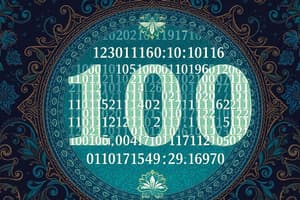Podcast
Questions and Answers
What is the binary equivalent of the decimal number 22?
What is the binary equivalent of the decimal number 22?
- 11100
- 10101
- 10110 (correct)
- 11010
Which of the following correctly converts the octal number (24)8 to decimal?
Which of the following correctly converts the octal number (24)8 to decimal?
- 24
- 20 (correct)
- 22
- 18
In binary number conversion, which remainder indicates the least significant digit (LSD)?
In binary number conversion, which remainder indicates the least significant digit (LSD)?
- Third remainder
- Last remainder
- First remainder (correct)
- Second remainder
How is the decimal number converted to binary using division?
How is the decimal number converted to binary using division?
What result do you get when converting (5C)16 to decimal?
What result do you get when converting (5C)16 to decimal?
What is the main purpose of a number system?
What is the main purpose of a number system?
Which number system is fundamental to computer science?
Which number system is fundamental to computer science?
What is the base or radix of the hexadecimal number system?
What is the base or radix of the hexadecimal number system?
In the binary number system, each digit represents what?
In the binary number system, each digit represents what?
Why is the octal number system commonly used in digital electronics?
Why is the octal number system commonly used in digital electronics?
Which digit values are included in the octal number system?
Which digit values are included in the octal number system?
What is the primary benefit of using the hexadecimal number system in computing?
What is the primary benefit of using the hexadecimal number system in computing?
How does one convert a number from one number system to another?
How does one convert a number from one number system to another?
Flashcards
Number System
Number System
A set of values used to represent quantities.
Binary Number System
Binary Number System
Uses only 0 and 1 to represent numbers and data in computers.
Decimal Number System
Decimal Number System
Uses digits 0-9 to represent numbers.
Octal Number System
Octal Number System
Signup and view all the flashcards
Hexadecimal Number System
Hexadecimal Number System
Signup and view all the flashcards
Radix (Base)
Radix (Base)
Signup and view all the flashcards
Binary Conversion
Binary Conversion
Signup and view all the flashcards
Number System Conversion
Number System Conversion
Signup and view all the flashcards
Decimal to Binary
Decimal to Binary
Signup and view all the flashcards
Least Significant Digit (LSD)
Least Significant Digit (LSD)
Signup and view all the flashcards
Most Significant Digit (MSD)
Most Significant Digit (MSD)
Signup and view all the flashcards
Binary Representation
Binary Representation
Signup and view all the flashcards
Power of 2 (Binary)
Power of 2 (Binary)
Signup and view all the flashcards
Study Notes
Computer Number System
- A number system is a technique used to represent numbers.
- Number systems are used in various applications, including to calculate the number of people in a movie hall or queue.
- The base or radix of a number system is the total number of digits available in that system.
- Number systems are crucial for converting numbers for technical computing purposes.
- Computer architecture relies heavily on various number systems (binary, octal, hexadecimal).
Types of Number Systems
- Decimal: A base-10 system using digits 0-9
- Binary: A base-2 system using digits 0 and 1, the most fundamental system in computer science
- Octal: A base-8 system using digits 0-7, commonly used in computer programming and digital electronics.
- Hexadecimal: A base-16 system using digits 0-9 and A-F (A = 10, B = 11, C = 12, D = 13, E = 14, F = 15), frequently used in computers to reduce the size of binary representation.
Conversion Steps of Number Systems
- Understanding the current number system's digits and their values
- Binary system uses powers of 2 starting from 2⁰
- Octal uses powers of 8.
- Hexadecimal uses powers of 16.
- To convert a decimal number to binary, keep dividing by 2 until you reach 0; remainders form the binary equivalent. (Least significant digit is the last remainder, the most significant digit is the first remainder).
Studying That Suits You
Use AI to generate personalized quizzes and flashcards to suit your learning preferences.




